 |
|||||
|
|||||
| Preview of Stamps Catalogue: VOLUME 1 |
 |
|||||
|
|||||
| Preview of Stamps Catalogue: VOLUME 1 |
Return To Catalogue - Postmaster issues part 1 - Postmaster issues part 2 - United States - Locals, carriers, postmasters and bogus issues; overview
Note: on my website many of the
pictures can not be seen! They are of course present in the catalogue;
contact me if you want to purchase it.
Postmaster issues exist for Alexandria, Baltimore, Boscawen, Brattleboro, Lockport, Millbury, New York, Providence and St.Louis. Furthermore envelopes were issued for Annapolis Md, Baltimore and New Haven. The postmaster issues have often the inscription 'POST OFFICE', the private local posts of this same period bear often the inscription 'Express' or 'Despatch'.
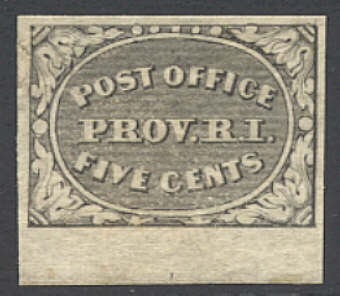

Genuine, image reproduced with permission from:
http://www.sandafayre.com
5 c black 10 c black

(Sheet of 12 stamps, reduced size, image obtained from a Shreves
auction)
These stamps were printed in sheets of 12 stamps, the upper right corner has the value "TEN" (see picture above), while all the others have the value "FIVE". There are 12 different types of these stamps (11 of the 5 and 1 of the 10 c). The 5 c exist with and without dot behind "CENTS", the 10 c never has a dot behind "CENTS".
Value of the stamps |
|||
vc = very common c = common * = not so common ** = uncommon |
*** = very uncommon R = rare RR = very rare RRR = extremely rare |
||
| Value | Unused | Used | Remarks |
| 5 c | RR | RRR | |
| 10 c | RRR | RRR | |
The full history of these stamps can be found in "The American Philatelist 31, 205-220, 1918" (see http://www.archive.org).

'V' shaped cancel (image obtained from a Siegel auction)
The usual cancel consists of a penmark in the shape of a 'V' (see The American Philatelist 31, 205-220, 1918 for examples).
Reprints exist, in general with one of the following letters on the backside: 'B O G E R T D U R B I N' (reprints without letters also exist). These are the so-called 'New-York reprints'.

The above stamp looks like a forgery made for George A. Hussey (see 'Philatelic forgers, their lives and works' by V.E. Tyler). It exactly resembles the picture given in this book. The 'S' of 'CENTS' is very far to the left, the 'O' of 'PROV' seems smaller than the other letters, the 'R' seems larger. The Hussey plates were made by a certain Charles A. Peabody (other sources say Mr.Padobie) in 1865.
The American Philatelist 31, 205-220, 1918, also mentions that S. Allan Taylor made forgeries of these stamps.
Another lithographed forgery:
And another forgery:

According to The American Philatelist 31, 205-220, 1918, the forger L.H.Mercier of Geneva (wrongly spelt as 'Mersier') made forgeries of these stamps. They are made from a photograph of a genuine stamp. They can be found with a New York postmark or a bar cancel. The left and top is heavily outlined (the genuine stamps only have heavy outlines at the right and bottom). These forgeries were also sold in London.
I know that Sperati also made forgeries of these stamps. I do not have any information about the distinguishing characteristics for these forgeries.
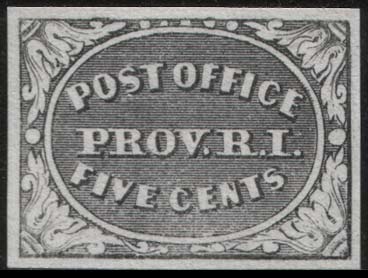
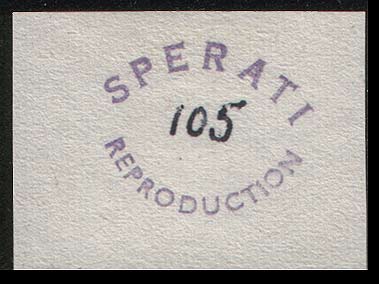
(Front and backside of a Sperati forgery)

These forgeries of New Haven and Providence are not listed in the
House of Stamps catalogue, but the first envelope is similar to
the one used for other forged envelopes. I've seen the 'James
Morris New Orleans Louisiana' envelope with forged Oldenburg
stamps from Peter Winter.
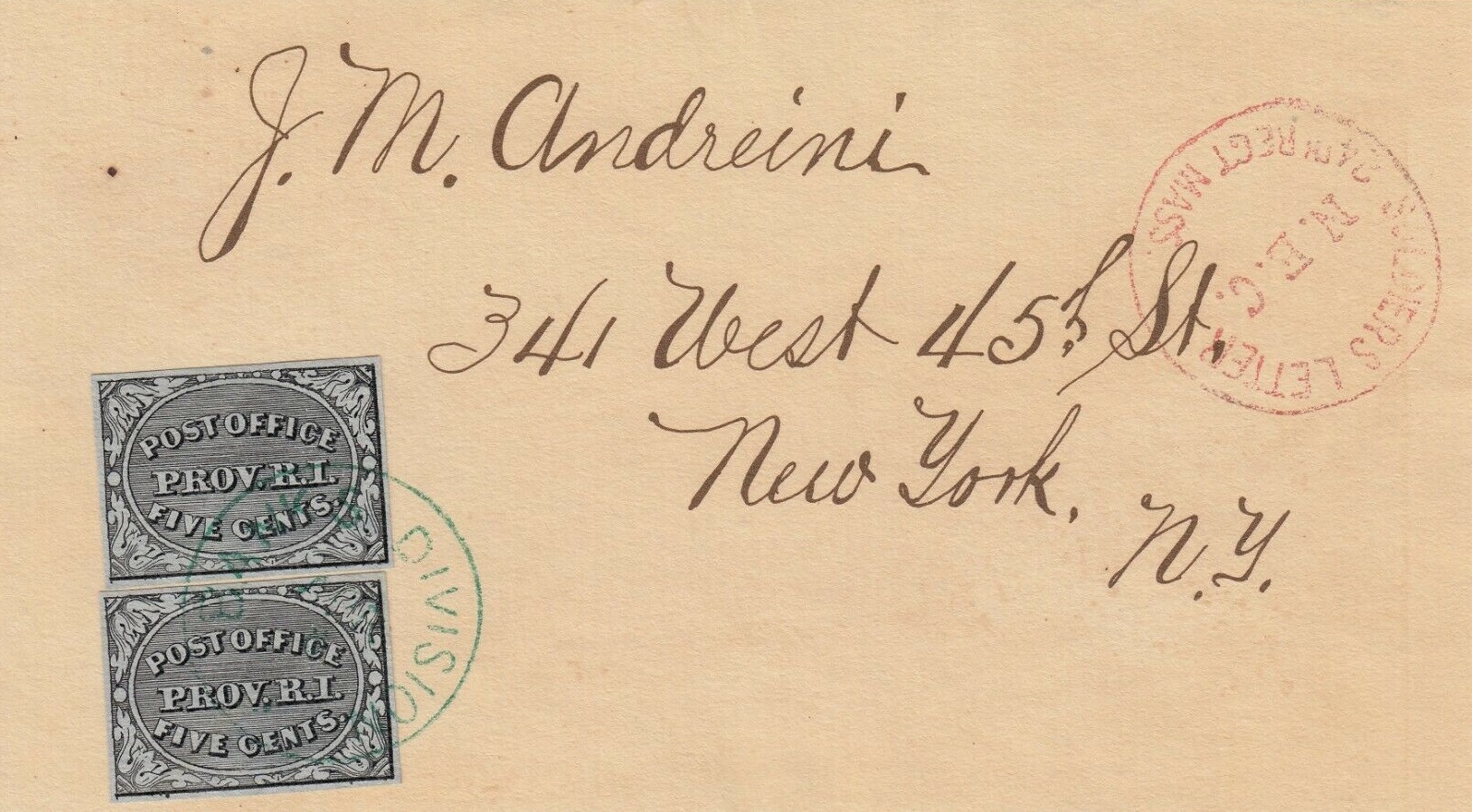
Peter Winter forgeries, the stamps, cancels and envelope are
forged.

Looks like a forgery to me as well.
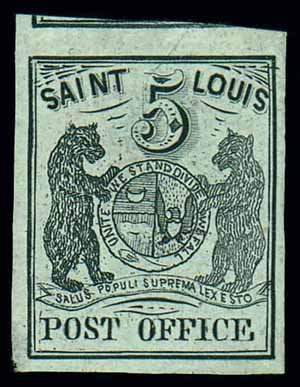



(Genuine stamps, images obtained from a Bennett auction)


(Genuine, reduced size)


(Images obtained from a Siegel auction)

Image obtained from a Shreves auction, with typical cancel. This
stamp used to be part of the Ferrari
collection.
5 c black 10 c black 20 c black
These stamps exist on greenish paper, on grey-lilac paper and finally on pelure paper. The 20 cent value was only discovered by Scott in 1869. Many experts first believed them to be forgeries.
They were printed in a plate constisting of 6 stamps (two colums and three rows). First, the three stamps on the left were in the 5 c value and the three at the right in the 10 c value. These first stamps (often referred to as first plate) are all on greenish paper. The upper 5 c and middle 5 c were then changed to 20 c stamps by scratching out the old value and inserting a primitive '20'. This is often referred to as the second plate. A small amount of these stamps of the second plate was also printed on greenish paper (thus making the 20 c on greenish paper a great rarity). Later grey-lilac paper was used for this plate, the 5 c on this paper is also a great rarity. A third plate exists, in which the '20' was re-changed back to a '5', they seem all to have been printed on thin pelure paper. At the same time, position five of the plate (5 c) got a black bar in the bottom of the number '5'.
Value of the stamps |
|||
vc = very common c = common * = not so common ** = uncommon |
*** = very uncommon R = rare RR = very rare RRR = extremely rare |
||
| Value | Unused | Used | Remarks |
| All values | RRR | RRR | |
Sheet reconstruction:
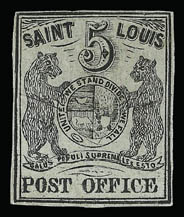 |
 |
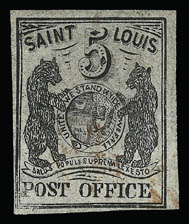 |

Third plate, position 5, note the 'bar' that was added to the
bottom left part of the '5'.


10 c value printed on both sides; extremely rare.
The following label (cut to shape, so without the text around it) from the 70th annual APS convention in 1956 seems to be offered often as a 'reprint':


The 'S' of 'SAINT' is slanting forwards in this 'reprint'. The
word 'POST OFFICE' too low. There are two almost horizontal lines
above these words (much more wavy in the genuine stamps).
I know that Samuel Allan Taylor made forgeries of at least the 5 c value (also in colour blue?). Other forgeries exist, also in bogus colours. I have seen 5 c blue, 5 c red. Also a photographic reproduction has been seen by me. If anybody has more information concerning these forgeries, please contact me!

A bogus 2 c black stamp in a different design, inscription 'St.
Louis P.O.'. I've also seen this stamp in the values 2 c black on
violet and 2 c black on green.
More deceptive forgeries exist, example:
I've also seen some stamps in bogus colors: 5 c red (see image above) and 5 c green. Also a 5 c black on green with a red 'ST LOUIS MO.' printed on it in red in three lines with a red line below and above this text.
Literature: http://www.columbianstamp.com/wp-content/uploads/2013/03/StLouisBears.pdf.
(Sorry, no image available yet)
3 c red